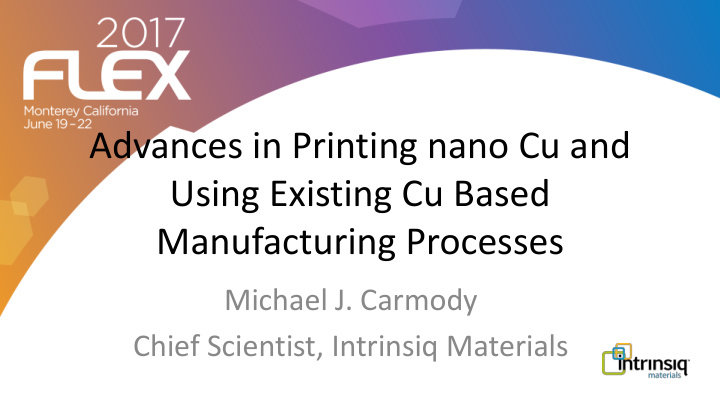



Advances in Printing nano Cu and Using Existing Cu Based Manufacturing Processes Michael J. Carmody Chief Scientist, Intrinsiq Materials
Why Use Copper? • Lower Cost than Silver. • Print on Numerous Substrates. • Reduce Electro migration - Reduce shorting of adjacent traces in fine line and pitch patterns. • Equipment Agnostic. • World is Tooled to Process Copper: Seamlessly Fits into Established Downstream Global Copper Based Manufacturing Processes (solder mask, soldering, plating, etc.). Objective: Show that copper can fit into time-tested and developing electronics manufacturing processes
IM Nanoparticle Production and Formulation Inks Screen Pastes Rapid Pilot Plant Analysis Prototyping Annual capacity • Extensive • Process pastes/inks: ~1 Scientific flexibility tonne Testing • Process facilities control • SEM / STEM • Fully / EDX instrumented
Four Applications, Various Deposition Methods, Substrates, Sintering Methods, and PCB Processes Application Deposition Fluid Substrate Sintering Bulk Method Method Factor/Adhesion Automotive Screen Print Paste LCP Formic Acid / 7X / 5B Lighting Inkjet Print Nitrogen Cu Foil Slot Die Ink Kapton Pulse Forge 12X, 10 N/cm Wiring Harness Screen Print Paste PET Formic Acid / 7X / 5B Nitrogen 3D Conformal Optomec AJ Ink Kapton Laser 4X / 5B Parts
Molex ASEP Process Steps 1 2 3 4 5 6 7 8 9 10 11 1. Stamp 2. Mold 3. Surface Pattern 4. Print (Screen Print or Inkjet) 5. Sinter (Heller Industries) 6. Electroplate Cu and Sn 7. Soldermask 8. Solderpaste 9. Place Components and Reflow 10. Remove Electrical Connections and Test 11. Remove from Carrier and Final Assembly
Advantages of the Application Specific Electronics (ASEP) Process v Standard PCB Package • Additive vs subtractive (saves 20 steps) • Use Common Surface finishes like ENEPIG (Electroless Ni Electroless Pd and Immersion Au) can be used for wire bonding bare die, solderability, and connector interfaces. • Uses far less water than standard PCB process – 20 gallons/m^2 v 400 gallons/m^2 for standard boards • Molded plastic can be recycled (instead of thrown in a landfill) • Lower total cost
Automotive Testing 1. Multi-layer circuitry 2. Three dimensional feature capable 3. Integrated connector function 4. Integrated rigid PCB functions 5. Integrated flexible circuit functions 6. Thermal management features 7. High current carrying features can be integrated 8. Could be used to combine first and second level silicon packaging 9. Fully additively manufactured which minimizes water use 10. Hermetically sealed interfaces are inherently possible 11. Continuously flow manufactured which minimizes labor cost Accelerated Life Testing 12. Highly automated manufacturing improves yields -Cycling from - 40˚C to 85˚C over 1000 hours and reliability -All parts passed 13. Minimizes the need for secondary assembly through part integration Under the Hood Testing (on the previous parts) 14. Validated for automotive under the hood -Temperature range extended to - 40˚C to 110˚C applications (-40 to 110 C) -All parts passed
Process Flow for Ultra Thin Copper Foil Slot die coat Photonically Sinter Plate and Etch
Ave Peel as f(Overlap Factor) 14 12 Peel Strength (N/cm) 10 8 6 4 2 0 Overlap Factor 0 5 10 15 20 We optimized peel strength as a function of Pulse Forge sintering parameters. Statistically, our best conditions averaged 9.5+/-0.6 N/cm for 18 samples. Conditions giving the best conductivity are not necessarily best for peel strength
Etching Results • Etch results were excellent • Very straight side walls due to very thin base copper to be etched. • Profilometry graph and cross section pictures show very straight side walls. • Very important for high speed and RF Designs.
Process Flow for Conformal 3D Printing Figure 2. Optomec AJ5X System, Tilt & Rotate Trunnion. 130 micron line width Optomec Jetting 808 nm Laser Test
Laser Sintering Copper on Kapton Not All Applications Need Bulk Copper Conductivity 10 14 9 12 8 7 Resistivity (x bulk Cu) Resistivity (x bulk Cu) 10 6 8 5 6 4 3 4 2 2 1 0 0 0 200 400 600 800 0 5 10 15 20 Laser Power (mW) Scan Speed (mm/s) Resistance as a function of laser power at 5 Resistance as a function of scan speed with laser mm/s scan speed power at 300 mW
Post Sinter Processing • SnPb with flux 5B ranking on Kapton • Uniform wetting of pad according to ASTM3359 • Unlike Ag pads, no savaging of metal by the solder is observed
Flex Application: Strain Gauges Copper strain gauge • Cyclic bending over 28 mm diameter pipe (0.3% strain) • More than 10,000 flexes without signal degradation Wheatstone Bridge Circuit diagram
Traditional Cable Harness vs. Printed Copper on PET -Bulky, heavy and limited flex -Lighter , fewer cable ties and fasteners and more because of insulation flexible. Print only copper needed. -Labor intensive to manufacture -Process is very automated
Large area screen printing at Swansea University Sintering in the Heller Conveyor Oven - 190˚C -7.5% Formic Acid in Nitrogen -Conveyed at 5 inches / minute
A Screen Printed, Heller Sintered Prototype Circuit
Conclusions • Sintered Copper materials can be printed on low Tg Flexible Substrates, plated and etched using conventional PCB process common world wide. • After sintering and common overcoating, copper survives solder reflow temperatures. • Manufactured parts with Copper can survive large, real world temperature testing (1000 hrs) and bend cycles (10,000 cycles). • A variety of sintering conditions were used. • A variety of deposition methods were employed.
Special Thanks • Nextflex • Molex-Vic Zaderej • NovaCentrix-Vahid Akhavan • Optomec-Mike Renn and Matt Schrandt • Heller Industries-Dave Heller & Michael Barnes • Intrinsiq colleagues in the US and UK
Recommend
More recommend